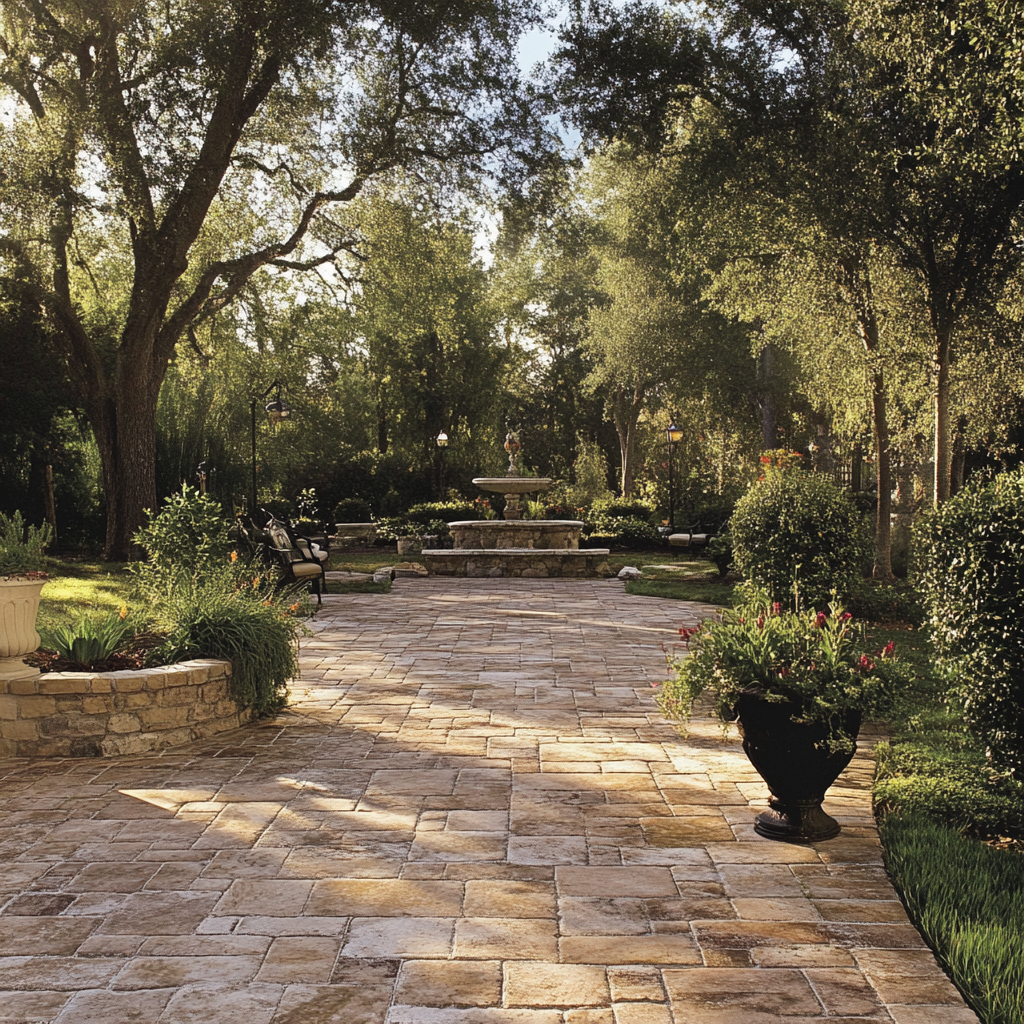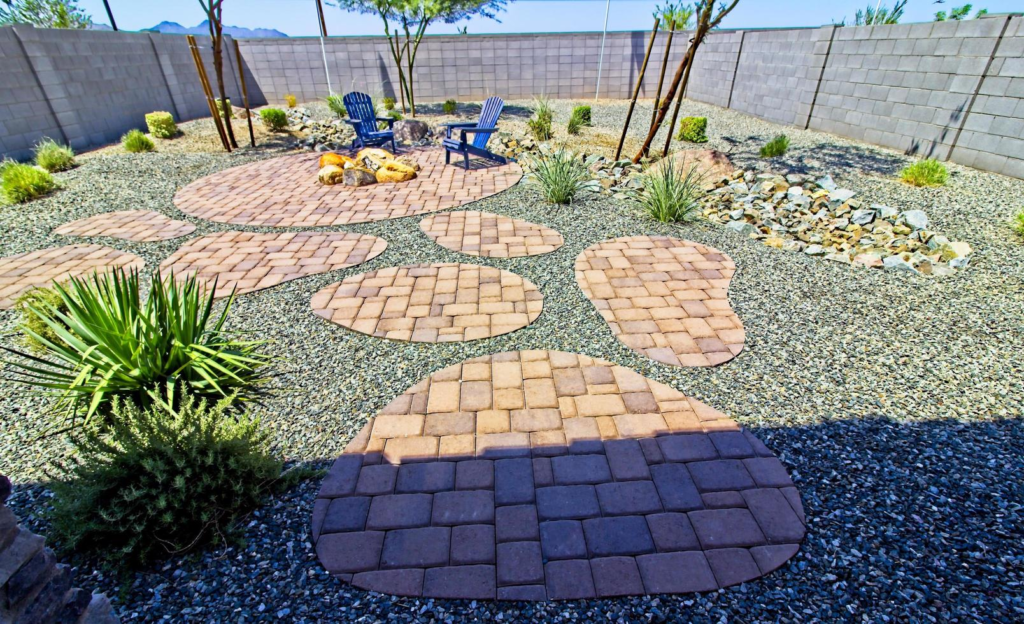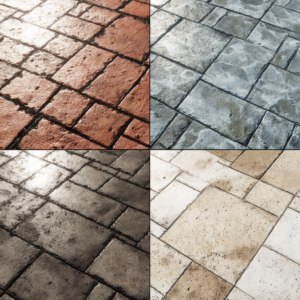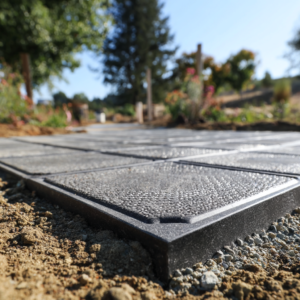As a hardscape specialist who’s transformed hundreds of backyards, I’ve discovered that the most extraordinary outdoor spaces begin with a simple shift in perspective: design outdoor patio areas not as extensions of your home, but as reflections of your life.
Forget sterile showrooms and impersonal catalogs – your patio should breathe with your personality, adapt to your rituals, and whisper comfort to your soul. In this guide, we’ll explore how to translate your unique story into stone, light, and greenery, creating an authentic sanctuary where memories are made.
You may also like: What is hardscape design? The secret to a beautiful outdoors
Jump to:
How to design outdoor patios the way you envision them

Every remarkable patio begins by honoring its environment and inhabitants. When I design outdoor patio spaces, I start by studying the land’s natural language.
The angle of the sunlight, the way rain moves across the property, the native wildlife patterns… this isn’t just technical diligence; it’s about creating spaces that feel inherently meant to be. For instance, a north-facing patio might embrace dappled shade with permeable travertine pavers that stay cool underfoot, while a south-facing space could incorporate reflective porcelain tiles to amplify winter sun.
Choice of materials
Selecting patio materials requires balancing functionality with aesthetics. For example, modern permeable pavers aren’t merely practical solutions for downpours, they’re ecological collaborators. By allowing rainwater to recharge aquifers instead of overwhelming storm drains, these systems create a symbiotic relationship with the environment.
The 2025 shift toward warm-toned neutrals (think sun-bleached limestone or driftwood-hued concrete) reflects a deeper craving for organic tranquility in our high-stimulus world. These hues provide a calm canvas that makes greenery pop while reducing visual fatigue.
For high-traffic entertainment zones, I often recommend denser materials like granite cobblestones whose crystalline structure withstands decades of pool parties and grill nights, developing a luminous patina that tells your family’s story in micro-abrasions.
The invisible architecture: light, sound, and microclimate

Truly transformative patio experiences must engage beyond the visual. Strategic water features, for example, serve as natural white-noise generators; a linear rill along a dining area can lower perceived temperatures by 5 °F while masking traffic sounds with its gentle murmur.
Lighting deserves special consideration as well. I like to layer moonlight-simulating downlights in mature oaks with path markers that cast soft aureoles of light, preventing the “runway effect” of harsh linear installations.
For fire features, consider the science of radiant heat: a sunken gas fire table with reflective lava rock will warm twice the area of a traditional fire pit.
In fact, one of our most requested innovations is microclimate sculpting, like using low stone walls to deflect winter winds or positioning shade pergolas to create cool zones without air conditioning. These invisible touches separate functional spaces from soul-nourishing ones.
Read also: Designing the perfect paver outdoor entertainment area for you
When hardscape and biosphere collaborate
Your patio shouldn’t frame nature – it should converse with it. The emerging practice of “biophilic weaving” involves strategic voids in hardscape that welcome ecological participation.
I often design patios with intentional gaps in retaining walls for resurrection ferns that pulse green after rains, and design paver joints wide enough for dwarf mondo grass to knit living lace between stones.
Vertical gardens on privacy screens do more than beautify. Species like Confederate jasmine release phytochemicals shown to reduce stress hormones. For edible integration, consider thyme or Corsican mint between stepping stones, given how their crushed fragrance underfoot activates sensory memory.

In bird-friendly designs, we incorporate seed-bearing native plants like firebush in raised planters, creating spontaneous wildlife theaters. This symbiotic approach transforms static patios into evolving ecosystems.
The responsibility of sustainable stewardship
Modern patio design carries ethical imperatives. At JS Brick, we’ve transitioned to cement-free binders in our installation systems, reducing the carbon footprint by nearly 40% compared to traditional methods.
If you decide to go for a permeable installation, rain chains paired with hidden infiltration galleries beneath patios can capture enough stormwater to irrigate surrounding gardens for weeks. Material selection now considers embodied energy; locally quarried coral stone requires 1/10th the transport emissions of imported slate.
Even maintenance plays a role: we recommend plant-based sealers that nourish soil microbiology rather than petroleum-based products that create hydrophobic barriers, though some cases will require more severe steps. These choices create patios that don’t just serve your family, but actively regenerate their environment, so keep that in mind if that’s a decisive factor in your investment.
Your story, written in stone – by no other than JS Brick

Ultimately, to design outdoor patio spaces well is to practice emotional archaeology, uncovering how you truly live, dream, and restore.
That couple who rediscovered their morning coffee ritual? We achieved it by angling their seating toward sunrise and using sound-absorbing sandstone to mute neighborhood noise. The multigenerational compound where grandparents watch grandchildren chase fireflies? Its graduated terraces came from studying sightlines at different heights. These aren’t construction projects – at the end of the day, they’re stages for life’s unfolding drama.
If you’re ready to begin your own narrative, reach out to us here at JS Brick. Our consultation process starts not with catalogs, but with listening, because the most profound patios aren’t designed for houses, but for the humans within them.



